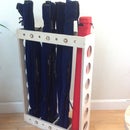Introduction: Fishing Rod Rack - Compact and Freestanding - Made With CNC Router
Here's a quick project- A freestanding fishing rod rack. It holds a large number of rods in a small space and can be moved horizontally without the rods falling out. Quite useful for moving the rods around the house.
I built this with a CNC router, but a slightly modified version could also be made with a table saw and a drill with a holesaw.
Step 1: Materials and Equipment
Materials
- 1/2 inch plywood ( I got two racks out of a little more than a quarter sheet)
- wood glue
- varnish or paint (optional)
Equipment
-CNC Router
- router bits (1/4 downcut, 1/4 upcut, and 3/4 flat - for holes)
- orbital or vibrating sander
- bar clamps
Step 2: Design
The purpose of this rack is to hold a large number of rods in a small area. While the rack has to be capable of holding rods with reels, it is optimized to hold rods with the reels removed. Many fisherman prefer to store reels separately.
The rack had to be able to hold the rods in place when tilted at an angle, so the the rack could be easily moved. One piece rods of seven feet or longer are common, so a loaded rack cannot be lifted and carried vertically in rooms with a standard 8 foot ceiling.
The image shows the parts to build two racks. Each column is one rack. The left set is for offshore rods with larger grips (1.7 inch holes). The right set will accommodate inshore and freshwater rods (1.5 inch holes).
From top to bottom:
side-1, side-2 , base. middle, top
Assembled dimensions: 12" H x 12.5" W x 7.5" D
Note the the mortices and slots should be adjusted to the exact width or you plywood.
Step 3: Cut
This part is easy if you have a CNC router:
- cut the holes first with a large bit (I used 3/4)
- cut all but the last 1/8 inch of profile with the downcut 1/4 bit
- finish the profile cut with a 1/4 upcut bit.
If you do not have a CNC router- you can do this with a hand router by building a template first from some 1/4 MDF using a table saw, hole saw, etc.
You can also build this directly with a table saw and drill/hole saw, but will have to replace the mortice and tenon joints with something else. I would probably use pocket screws.
Step 4: Assemble
Glue and clamp. If your mortices are tight, the part will already be close to square.
I didn't bother to put a finish on mine, but if you want to finish the part, it is not a bad idea to finish before assembling. Place painters tape where the glue lines will be before applying the finish. This will allow the glue to penetrate better
Step 5: Test Drive
Rods fit well. I decided to add some felt feet to allow the rack to be slid around on a wood floor, although the rack can be tilted and carried without the rods shifting around.
This is the inshore rack all loaded up!













